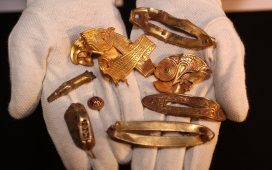The ‘city-destroying’ asteroid hurtling toward Earth is being carefully watched by hundreds of the world’s most powerful telescopes.
Now, NASA has quietly increased the chances that this deadly space rock will smash into the planet in 2032.
The space agency predicts that the asteroid 2024 YR4 has a one-in-38, or 2.6 per cent, chance of hitting.
Those are the same odds as having your number come up on a spin of a standard American roulette wheel.
When it was discovered in December last year, NASA estimated that the chances of 2024 YR4 hitting us were one in a thousand.
However, as more data has been gathered about its orbit, the impact probability has rapidly increased.
Currently, the odds of 2024 YR4 hitting Earth on December 12, 2032, are double what they were at the end of January less than three weeks ago.
With an estimated diameter of 54 metres (177ft), or a little taller than Nelson’s Column in Trafalgar Square, that collision has the potential to cause enormous amounts of damage.

NASA has quietly increased the chances that the city-destroying asteroid 2024 YR4 could hit Earth in 2032 once again (stock image)
The asteroid was discovered on December 27 by the NASA-funded Asteroid Terrestrial-impact Last Alert System (ATLAS) telescope in Chile.
Early calculations of its orbit quickly showed that there was a slim chance of the near-Earth object (NEO) making a close pass of the planet in the next decade.
However, as astronomers made more observations and arrived at a better estimation of the asteroid’s orbit, the probability of a collision continued to rise.
On January 27, 2024 YR4 truly set alarm bells ringing when it became the only large asteroid with an impact probability greater than one per cent.
This prompted NASA to award the asteroid a score of three on the Torino Scale, a standard measure for the danger of NEOs.
This rating is extremely rare since it can only be given to an object over 20 metres (65ft) in diameter with an impact probability greater than one per cent.
The Torino scale describes this threat as: ‘A close encounter, meriting attention by astronomers. Current calculations give a 1% or greater chance of collision capable of localized destruction.’
Were the asteroid to hit Earth, NASA estimates that the explosion would be equivalent to eight megatons of TNT.

NASA now estimates that the 54 metre-wide (177ft) asteroid has a one-in-38 chance of hitting Earth. Those are the same odds as a specific number coming up on a standard American roulette wheel
That is more than 500 times the power of the atomic bomb dropped on Hiroshima during World War II.
The resulting blast would be similar to that caused by the Tunguska Asteroid, which flattened 830 square miles (2,150 square km) of Siberian forest in 1908 – an area more than double the size of New York.
Based on current estimates of the asteroid’s orbit, astronomers have calculated a ‘risk corridor’ of locations that could be hit if it were to collide with Earth.
This path stretches from northern South America, across sub-Saharan and North Africa, and into South Asia.
Worryingly, the risk corridor passes over eight of the world’s most populated cities, including Bogota in Colombia, Lagos in Nigeria, as well as Mumbai and Chennai in India.
Those cities alone have a combined population of over 110 million people, who could be in serious danger from an asteroid impact.
In the history of astronomy, only one other asteroid has ever been given a Torino Scale rating of three or higher – that being the 185-metre (600ft) 99942 Apophis.
Apophis, nicknamed the ‘God of Chaos’ asteroid, was briefly escalated to a four on the Torino Scale in late 2004 before rapidly dropping back towards zero.

The estimated ‘risk corridor’ for the asteroid’s impact (red line) passes over eight of the world’s 100 most populated cities, with a combined population of 110 million people
Astronomers around the world are currently holding out hope that 2024 YR4 will soon follow a similar pattern.
Most NEOs have a higher impact probability right after they are detected with the risk dropping off as scientists gather more data about their orbits.
At first, as lots of new data comes in, the probability tends to sharply increase creating the impression of a rapidly growing risk.
However, NASA and the European Space Agency (ESA) currently predict that this should be followed by a drop in probability once the astronomers can be more certain about the asteroid’s orbital path.
NASA spokesperson Molly Wasser wrote in a blog post: ‘As more observations of the asteroid’s orbit are obtained, its impact probability will become better known.
‘It is possible that asteroid 2024 YR4 will be ruled out as an impact hazard, as has happened with many other objects that have previously appeared on NASA’s.’
She adds: ‘It is also possible its impact probability will continue to rise.’
Both NASA and ESA will continue to make observations of the asteroid until April at which point it will become too faint to observe until it returns around June 2028.

If the asteroid did hit Earth, the resulting blast could topple residential structures within a 8.5-mile radius (13.7 km) (shown as blue) and break windows everywhere within 24.6 miles (39.6km) (yellow)
In a rare emergency decision, ESA has also been granted access to the James Webb Space Telescope in March to better assess the risk posed by 2024 YR4.
The JWST will record the heat emitted by the asteroid using its infrared sensors which will give a more accurate estimate for its size.
Those measurements will be key to making a decision on whether action needs to be taken to divert the asteroid from its course.
If the decision is made to push the asteroid off its current course, the most likely option would be using a ‘kinetic impactor’ to push it aside by ramming a satellite into the asteroid as fast as possible.
In 2022, NASA’s DART mission showed that it was possible to significantly alter the trajectory of a large asteroid with a satellite collision.
However, with only eight years until the asteroid arrives, some scientists have cast doubt on the plan to deflect the killer asteroid.
In a post on X, Dr Robin George Andrews, a volcanologist and author based in London, points out that we ‘have less than eight years to potentially deal with it’.
‘You need 10 years or more to build, plan and execute an asteroid deflection mission,’ he said.










